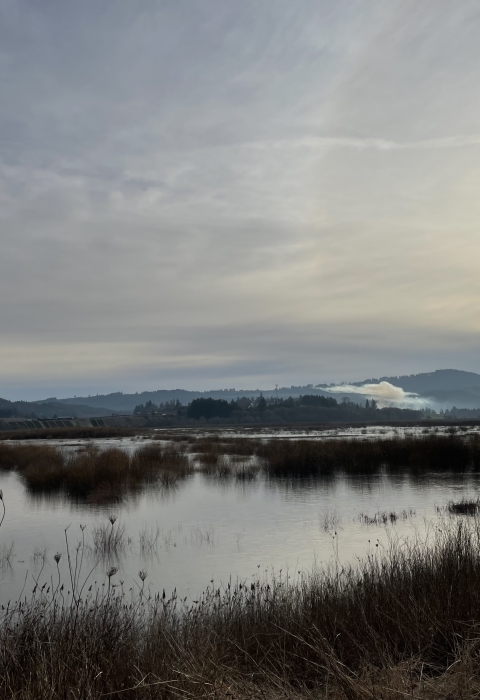During the summer of 2024, visitors to Wapato Lake National Wildlife Refuge will see something that hasn’t been seen regularly in 100 years: a wetland full of water. Before the refuge was established, water was pumped out of Wapato Lake every spring. No longer a necessary source of irrigation or farmland, Wapato Lake will be allowed to retain shallow water through the summer to benefit wildlife, plants, and people.
Historically, Wapato Lake filled and receded with the rise and fall of the Tualatin River. Rich peat soils found in the lakebed supported wetland habitats that were surrounded by hardwood forests on the adjacent floodplains. Throughout the seasons, migratory birds, including songbirds and waterfowl, rely on the area as a safe place to rest and recharge. Resident bald eagles can be found hunting the edges of Wapato Lake, deer hide in the trees, and rough-skinned newts hide amongst the shallow water, mud and plants.
This is the first year that water will be left in Wapato Lake throughout the entire year, allowing wetland plants to establish. Refuge managers and partners will monitor Wapato Lake and the impacts of holding water on plants, water quality, and wildlife. The information collected will help refuge managers refine habitat management and restoration plans to benefit wildlife, plants, and people.
In coordination with Joint Water Commission, Department of Environmental Quality, Clean Water Services, Tualatin Valley Irrigation District, and Washington County Vector Control, the refuge is monitoring Wapato Lake for changes such as algae blooms, water quality, and changes in mosquito populations on the refuge which could pose a risk to human health and safety. This monitoring is ongoing and will continue throughout and after the summer.
Healthy wetlands and riparian riparian
Definition of riparian habitat or riparian areas.
Learn more about riparian habitat are an important part of maintaining water quality in the Tualatin River system, which provides water for drinking, agriculture, and technology to approximately 500,000 people in the Tualatin Valley. As Oregon’s newest national wildlife refuge national wildlife refuge
A national wildlife refuge is typically a contiguous area of land and water managed by the U.S. Fish and Wildlife Service for the conservation and, where appropriate, restoration of fish, wildlife and plant resources and their habitats for the benefit of present and future generations of Americans.
Learn more about national wildlife refuge , the Service is working to restore the emergent wetland and riparian habitat across 900 acres – a multi-year process. Repair of the embankment along the western edge of Wapato Lake is needed in the near future and will require the lakebed to be dewatered again for construction access. This first year of holding water in Wapato Lake year-round will inform the restoration process in the years to come.
Holding water in Wapato Lake is expected to benefit visitors to the refuge’s hiking trails, as waterfowl and other wildlife will continue to use the wetland throughout the summer. It is not expected to impact those participating in the state’s fall hunting season. Visitors to the refuge can continue to enjoy the 2.6-mile levee trail from February through the end of November, with reduced trail mileage in October and November.
Keeping water in Wapato Lake year-round will support the refuge’s ongoing work with the Confederated Tribes of the Grand Ronde to plant and harvest First Foods, including wapato. For generations, the Tualatin Kalapuya people relied on the abundance of resources found at Wapato Lake, which remains a culturally significant landscape to their descendants who are part of the Confederated Tribes of Grand Ronde. Wapato Lake continued to provide for people during the 20th century, as the lakebed supported a vibrant onion farming economy in Gaston. That legacy is an important part of the community.
As the landscape changes, Wapato Lake is an essential place for wildlife and for people to connect with wildlife. We are committed to honoring the ancestral homes of indigenous communities and celebrating a landscape where all people can experience nature and create new traditions.




